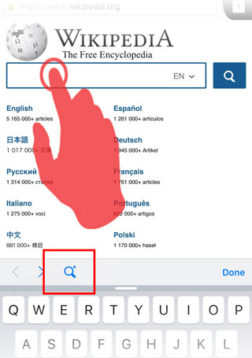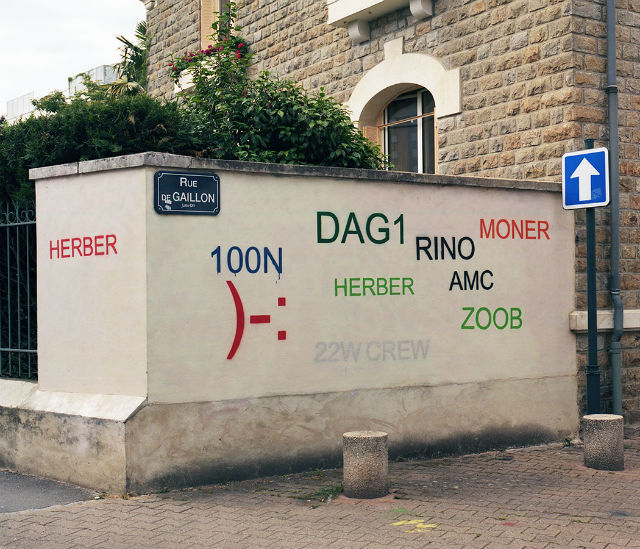 Mathieu Tremblin's Tag Clouds (2010). Images courtesy the artist
Mathieu Tremblin's Tag Clouds (2010). Images courtesy the artist
In the age of endless design blogs vying to fill your morning commute with easily consumable recycled images, facts and research are secondary to likes and shares. French artist and activist Mathieu Tremblin found this out the hard way, when images of his street artwork Tag Clouds went viral and he won praise all over the internet for his clever translation of ugly and unreadable graffiti tags into legible text.
The only problem? Bloggers had completely misinterpreted Tremblin’s intentions—Tag Clouds is actually a visual celebration of the almost-forgotten internet phenomenon of the tag cloud. The act of rewriting graffiti tags was fairly incidental.
Tremblin very quickly lost control of how Tag Clouds was viewed and shared. “After all those shitty articles and sterile comments I read online about my work, it took me a while to get my thoughts clear,” he tells The Creators Project. We talked to him to learn more about how it feels to have your artwork reduced to clickbait.
The Creators Project: Tag Clouds only went viral this month—but the project is actually six years old. Why do you think it has maintained relevance?
Mathieu Tremblin: I guess on the contrary, I’m realizing that the Tag Clouds intervention is not as relevant as it was in 2010 when I started it. The initial idea came from the awareness that mass access to the internet in the beginning of the 2000s permitted a lot of street writers living away from the main cities in Europe to share their work in the way they wanted to, on homemade websites and CMS blogs that used tag clouds… Now, social networks and likes and shares have become the main way to consume an artwork.
Yeah—and you don’t really see tag clouds on websites anymore.
In 2000, we would physically encounter work and then spread it digitally. Now we are mostly experiencing online documentation of real life graffiti before we can encounter it physically. Tag Clouds was initially about this balance between the IRL and URL experience of tagging. Formerly, tag clouds were still the main way to draw personal paths through contents, websites and blogs in 2010.
Now, we are in the post-Snowden era that’s ruled by big corporations—Google, Amazon, Apple, Facebook—who are orienting through algorithms the content we can access and opinions we can develop. Reception is filtered. The internet used to be an open source space when I started to use it in 1996. Now internet users are not considered as responsible citizens—but rather potential consumers.
 The Tag Clouds wall before Tremblin painted over it in 2010
The Tag Clouds wall before Tremblin painted over it in 2010
How did Tag Clouds go viral?
Tag Clouds went viral firstly on name writing and urban intervention dedicated blogs like Rebel Art and All City. Those sites were carefully following the work of writers and artists and trying to diffuse it in the respect of its original intent, as they were aware that experience through documentation is totally different than direct experience.
But then comes the clickbait.
Yes, the second wave of virality came from Reddit, when user 321Cheers took the pictures from a recent online article of Süddeutsche Zeitung Magazin and copy-pasted those without mention of title or author—that was on July 23. Actually I was initially kind of happy [about the anonymity] because it took [my work] back to its first state of reception—a mural encountered by passers by is anonymous and not recognisable as art. It ended up with 100,000 views and 500 comments in a few hours and a lot a clickbait blogs started to reblog it without doing the basic journalistic research you would have expected them to do.
Those clickbait blogs ended up totally changing the meaning of Tag Clouds.
Especially one of the first rebloggers, who titled his article “Guy Paints Over Shit Graffiti And Makes It Legible” and transformed my simple gesture of “turning a hall of fame of tags into tag clouds” into an anti-graffiti hygienist lampoon.
I guess that's the main reason it’s now spread all over the internet—not because of the quality of the work but more because of the consumerist and reductive perspective blogs like Design You Trust put out there. They made me look like the emissary of a solution against graffiti, whereas my intent was actually totally the opposite—I’m pro-name writing as I’m a former writer.
 Tag Clouds in 2011
Tag Clouds in 2011
Street art is so popular now, especially online—has it lost its subversiveness?
A part of recent street art which could be called global street art or neo-muralism is used nowadays by advertisers as an instrument of power... It became a consensual form of globalized culture which mostly goes against the interest of local communities and in particular writers or artists who get in trouble for expressing themselves without permission or cannot even get permission to intervene. Brad Downey made a good demonstration of this ironic situation in one of his last interventions called Fiscal Shifts and Problem Solving as Mural in 2015 in Rome, using the budget of a mural he was invited to paint for solving the daily problems the inhabitants were suffering from.
 Tag Clouds in 2012
Tag Clouds in 2012
You’ve used street art techniques yourself in subversive ways though—as with your more recent work Liberté Égalité Soldes.
Liberté Égalité Soldes is an advertising slogan for the sales of [French kitchen store] Cuisinella that appeared on French billboards in January 2015—around the same time as the Charlie Hebdo terrorist attack—inspired by France’s national motto. The advertising slogan is also in a way inspired by subversive graffiti written in May 1968 all over France and that spirit has been co-opted by advertisers. I found this outrageous, especially in light of France’s mass surveillance laws and our national “state of emergency” that permits the police and intelligence services to act [outside of their jurisdictions]. It made sense for me to paint the slogan and give it back a critical meaning: the French government is putting all historical values, social progresses and individual freedom on sale.
You don’t call yourself a street artist—why is that?
Personally, I consider myself an artist, sometimes doing actions and interventions in urban spaces, sometimes creating artworks in art-dedicated spaces or on online platforms like my Twitter account @twittOEuvres which is a text piece in itself. So my work is always framed by the space. This way of doing things is directly rooted in the avant-garde movement, the point of which was always to go beyond the definition of art, beyond art itself. So I don’t only focus on graffiti, even though I must confess I really like to play with the rules of name writing, especially in this complex period where street art is experienced both on the street and on the internet due to daily use of digital technologies and mass access to smartphones.
You can find out more about Mathieu Tremblin’s work here.
This article originally appeared on The Creators Project Australia/New Zealand.
Related:
Chroma Key Graffiti Reveals Reality-Bending Digital Art
Check Out These New Water-Focused Murals from a Paddleboarding Street Artist
For The Open Source Graffiti Movement, Digitized Tags Are Just The Beginning

 Every four years, athletes are tested in their skills as the world comes together to celebrate the Olympic Games. Over the years, the level of attention and care given to fulfilling every material comfort and need of athletes to allow them to be at the peak of performance when time comes has been incorporated into the logistics of the event. For the supporters, its a whole different story, and this year with the games being held in Rio de Janeiro, there is even a language barrier that tourists would have to overcome.
Every four years, athletes are tested in their skills as the world comes together to celebrate the Olympic Games. Over the years, the level of attention and care given to fulfilling every material comfort and need of athletes to allow them to be at the peak of performance when time comes has been incorporated into the logistics of the event. For the supporters, its a whole different story, and this year with the games being held in Rio de Janeiro, there is even a language barrier that tourists would have to overcome.










 Images courtesy of the artist. Background photos from AFP
Images courtesy of the artist. Background photos from AFP












 Screencaps
Screencaps 

 Mathieu Tremblin's Tag Clouds (2010). Images courtesy the artist
Mathieu Tremblin's Tag Clouds (2010). Images courtesy the artist The Tag Clouds wall before Tremblin painted over it in 2010
The Tag Clouds wall before Tremblin painted over it in 2010 Tag Clouds in 2011
Tag Clouds in 2011 Tag Clouds in 2012
Tag Clouds in 2012